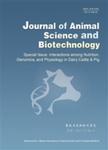Effects of different energy levels in low-protein diet on liver lipid metabolism in the late-phase laying hens through the gut-liver axis
作者机构:Yunnan Provincial Key Laboratory of Animal Nutrition and Feed ScienceFaculty of Animal Science and TechnologyYunnan Agricultural UniversityKunming 650201China College of Animal ScienceAnhui Science and Technology UniversityBengbu 233000China State Key Laboratory of Animal NutritionInstitute of Animal SciencesChinese Academy of Agriculture SciencesBeijing 100193China Shanghai BIOZERON Biotechnology Co.LtdShanghai 201800China WOD Poultry Research InstituteBeijing 100193China
出 版 物:《Journal of Animal Science and Biotechnology》 (畜牧与生物技术杂志(英文版))
年 卷 期:2024年第15卷第5期
页 面:2122-2136页
核心收录:
学科分类:1002[医学-临床医学] 0905[农学-畜牧学] 100201[医学-内科学(含:心血管病、血液病、呼吸系病、消化系病、内分泌与代谢病、肾病、风湿病、传染病)] 10[医学]
基 金:supported by China Agriculture Research System(No.CARS-40-S25) National Key R&D Program of China(No.2022YFD1601905) the Industrial Innovation Talent Project of the“Xing Dian Talent Support Program”of Yunnan Province in 2022(XDYC-CYCX-2022–0029) the Young Talent Project of the“Xing Dian Talent Support Program”of Yunnan Province in 2023
主 题:Cecal microbiome Energy/protein imbalance Late-phase laying hens laying hens Liver lipid metabolism Low-protein diet Multi-omics
摘 要:Background The energy/protein imbalance in a low-protein diet induces lipid metabolism disorders in late-phase laying *** energy levels in the low-protein diet to adjust the energy-to-protein ratio may improve fat deposition,but this also decreases the laying performance of *** study investigated the mechanism by which different energy levels in the low-protein diet influences liver lipid metabolism in late-phase laying hens through the enterohepatic axis to guide feed optimization and nutrition strategies.A total of 288 laying hens were randomly allocated to the normal-energy and normal-protein diet group(positive control:CK)or 1 of 3 groups:lowenergy and low-protein diet(LL),normal-energy and low-protein diet(NL),and high-energy and low-protein diet(HL)*** energy-to-protein ratios of the CK,LL,NL,and HL diets were 0.67,0.74,0.77,and 0.80,*** Compared with the CK group,egg quality deteriorated with increasing energy intake in late-phase laying hens fed low-protein *** fed LL,NL,and HL diets had significantly higher triglyceride,total cholesterol,acetylCo A carboxylase,and fatty acid synthase levels,but significantly lower hepatic lipase levels compared with the CK *** transcriptome sequencing revealed that genes involved in fatty acid beta-oxidation(ACOX1,HADHA,EHHADH,and ACAA1)were downregulated,whereas genes related to fatty acid synthesis(SCD,FASN,and ACACA)were upregulated in LL group compared with the CK *** of the cecal microbiome showed that in hens fed an LL diet,Lactobacillus and Desulfovibrio were enriched,whereas riboflavin metabolism was *** metabolites that were most significantly affected by the LL diet included several vitamins,such as riboflavin(vitamin B2),pantethine(vitamin B5 derivative),pyridoxine(vitamin B6),and 4-pyridoxic *** A lipid metabolism disorder due to deficiencies of vitamin B2 and pantethine originating from the metabolism of the cecal microb



